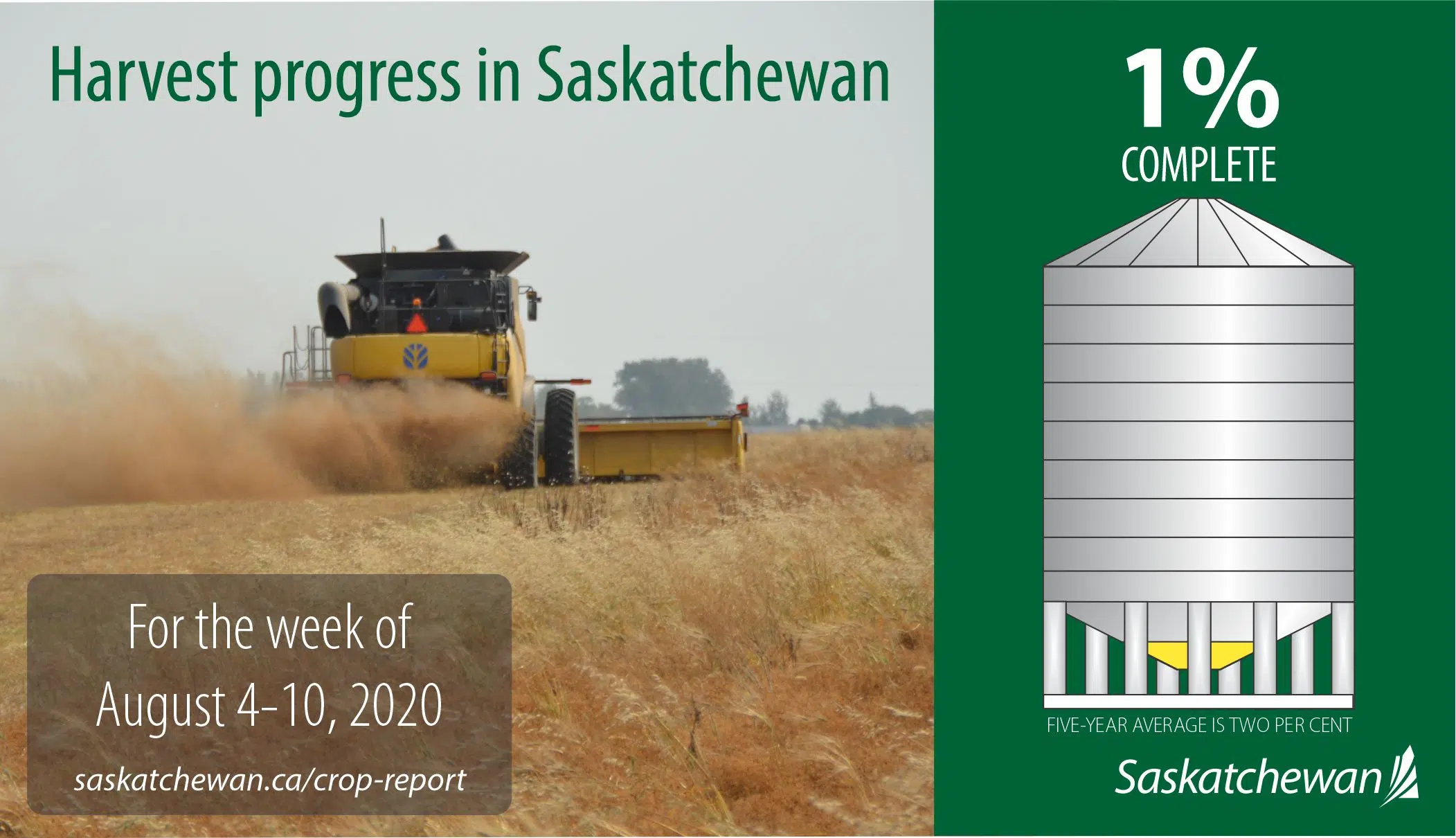
Most areas can use an extra shot of rain prior to harvest later this month.
Saskatchewan Agriculture’s weekly crop report rates topsoil moisture on cropland at 51 percent adequate, 37 percent short and 12 percent very short.
“Farmers have noted that they would like some more rain to support crop development and ensure good grain fill,” said Sara Tetland, an extension specialist with the Saskatchewan Ministry of Agriculture. “Most of the central and parts of the southern region could use more rain.”
The harvest is underway in some southern regions. One percent has been combined and two percent swathed or ready to straight cut.
Fifty-two percent of fall rye, 19 percent of winter wheat, six percent of pea and three percent of lentils are in the bin.
Haying is in the final stages with yields coming in below average. Alfalfa is 1.2 tons per acre on dryland, 1.1 tons per acre for alfalfa/bromegrass, 1.0 tons per acre to tame and wild hay and 1.8 tons per acre for greenfeed. Estimated average irrigated hay yields are 3.0 tons per acre for alfalfa, 2.7 tons per acre for alfalfa/bromegrass and 2.8 tons per acre for greenfeed.
The detailed region-by-region crop report is below:
SOUTHEAST
Harvest is underway in the region, with some farmers starting to combine and many more desiccating. Currently, one per cent of the crop is combined and three per cent is swathed or ready to straight-cut. The five-year average (2015-2019) for this time of year is three per cent of the crop combined and five per cent of the crop swathed or ready to straight-cut.
Sixty-six per cent of the fall rye, 26 per cent of the winter wheat, nine per cent of the field peas, seven per cent of the barley and three per cent of the lentils are now in the bin.
There were scattered rain showers throughout the region this week, ranging from a couple millimeters to over an inch in some areas. The area south of Broadview received the most rain in the province this week with 39 mm. The Grenfell area received 37 mm, the Odessa area 33 mm, areas west of Weyburn 31 mm, the Moosomin area 20 mm, the Briercrest area 12 mm, the Marquis area 7.5 mm, the Carnduff area five mm and the Lampman area three mm.
Moisture conditions remained around the same level as last week. Cropland topsoil moisture is rated as 47 per cent adequate, 48 per cent short and five per cent very short. Hay and pasture land topsoil moisture is rated as 28 per cent adequate, 53 per cent short and 19 per cent very short.
The majority of crop damage this week was due to wind, dry conditions and localized reports of hail. There were also reports of grasshoppers, bertha armyworms and diamondback moths in the region.
Haying and baling is wrapping up in the region and yields are lower than normal. Dry conditions have limited pasture growth in the region.
Farmers are busy hauling bales, desiccating crops and starting to combine in some areas.
SOUTHWEST
Farmers are starting to desiccate and swath their crops, and more farmers are starting to combine each day in the region. Currently, two per cent of the crop is combined and four per cent is swathed or ready to straight-cut. The five-year average (2015-2019) for this time of year is four per cent of the crop combined and five per cent of the crop swathed or ready to straight-cut.
Fifty-four per cent of the fall rye, 14 per cent of the field peas, eight per cent of the barley and four per cent of the lentils are now combined.
Minimal rainfall was received in the southwest region this week, ranging from zero to 11 mm in the Lucky Lake area. The Cabri area received eight mm, the Swift Current area six mm and the Tyner and Mortlach areas three mm. The three southern Crop Districts in the southwest region, Crop District 3ASW, 3BS and 4A, reported no rainfall this week.
The lack of rain and hot temperatures continue to deteriorate topsoil moisture conditions in the region. Cropland topsoil moisture is rated as 38 per cent adequate, 35 per cent short and 27 per cent very short. Hay and pasture land topsoil moisture is rated as 25 per cent adequate, 41 per cent short and 34 per cent very short.
The majority of crop damage this week was due to heat, dry conditions and wind. There were reports of grasshoppers in the region as well.
Hay yields are lower than normal in the region and lack of rainfall has reduced pasture growth.
Farmers are busy wrapping up baling, hauling bales, desiccating, swathing and starting to combine.
WEST CENTRAL
Harvest operations are just beginning in the region, with farmers starting to desiccate their crops. Currently, one per cent of the crop has been combined and two per cent has been swathed or is ready to straight-cut.
Thirty-one per cent of the fall rye, 25 per cent of the winter wheat and three per cent of the field peas and lentils have been combined.
Small amounts of rain were received throughout most of the west-central region this week. The Netherhill area received the most rain in the region with 23 mm. The Harris and Sonningdale areas received 11 mm, the Macklin area 10 mm, the Biggar area nine mm, the Langham area eight mm, the Smiley area six mm and the Conquest area four mm.
There was a slight reduction in topsoil moisture in the region this week. Cropland topsoil moisture is rated as 60 per cent adequate, 37 per cent short and three per cent very short. Hay and pasture land topsoil moisture is rated as 48 per cent adequate, 45 per cent short and seven per cent very short. Rain and cooler conditions would be welcome to support crops during the grain filling stages.
The majority of crop damage this week was due to heat, wind and dry conditions. There were also reports of localized hail. Some pastures are starting to suffer due to hot, dry conditions.
Farmers are busy hauling bales, starting to desiccate crops and getting ready for harvest.
EAST CENTRAL
Crops continue to rapidly dry down in the region, with some farmers beginning harvest operations. Less than one per cent of the crop has been combined at this time and two per cent has been swathed or is ready to straight-cut. Farmers have reported that the heat and dry conditions have resulted in some crops ripening prematurely and not filling properly.
Thirty-three per cent of the fall rye, 10 per cent of the winter wheat, four per cent of the field peas and two per cent of the lentils are now in the bin.
There were scattered rain showers in the east-central region this week. Areas north of Raymore received the highest amount of rain in the region this week with 20 mm. The Kelliher area received 16 mm, the Foam Lake area 10 mm, the Lipton and Rama areas eight mm and the Earl Grey, Kenaston and Meacham areas seven mm.
Topsoil moisture conditions have continued to deteriorate in the region. Cropland topsoil moisture is rated as 36 per cent adequate, 45 per cent short and 19 per cent very short. Hay and pasture land topsoil moisture is rated as 22 per cent adequate, 51 per cent short and 27 per cent very short.
The majority of crop damage this week was due to wind, dry conditions and heat.
Haying is wrapping up in the region and yields are lower than normal. The warm, dry weather conditions have also limited pasture growth in the region.
Farmers are busy wrapping up haying and baling, getting equipment ready for harvest and starting to desiccate pulse crops.
NORTHEAST
Crops are rapidly advancing in the region again this week. The warm temperatures have helped crops progress and some crops are starting to turn color. Farmers have started to swath and combine winter cereals in the region. Swathing and desiccating of other crops is expected to start in the next couple weeks.
Small amounts of rain were received throughout most of the northeast region. The Lakeland and Paddockwood areas north of Prince Albert received the highest amount of rainfall in the region this week with 20 mm. The Arborfield area received 14 mm, the Vonda area 12.9 mm, the Garrick area eight mm, the Birch Hills area 5.2 mm and areas south of Tisdale three mm.
Topsoil moisture conditions have slightly reduced in the area, with more land being rated as short. Cropland topsoil moisture is rated as 80 per cent adequate, 17 per cent short and three per cent very short. Hay and pasture land topsoil moisture is rated as 80 per cent adequate, 18 per cent short and two per cent very short. Crop District 8B reported that 39 per cent of the cropland and 47 per cent of the hay and pasture land is short or very short for topsoil moisture at this time.
There were some reports of crop damage this past week caused by winds, dry conditions and heat.
Farmers are busy wrapping up haying and baling, hauling bales and getting ready for harvest.
NORTHWEST
Crop development continued to progress in the region this week. Warm temperatures and rain showers are expected to benefit crops, but there have been reports of heat damage to canola crops.
Most of the northwest region received rain this week, with many areas receiving half of an inch to almost an inch. The Mayfair area received the highest amount of rain in the region with 23 mm. The Lloydminster area received 20 mm, the Hafford area 13 mm, the Barthel area 12 mm, the Spiritwood area 6.5 mm and the Borden area three mm.
Moisture conditions remained relatively stable in the region this week. Cropland topsoil moisture is rated as five per cent surplus, 78 per cent adequate, 16 per cent short and one per cent very short. Hay and pasture land topsoil moisture is rated as two per cent surplus, 78 per cent adequate, 19 per cent short and one per cent very short.
The majority of crop damage this week was due to wind, heat and localized reports of hail. There have been multiple reports of crops lodging due to the wind and heavy rainfall in some areas. There was also damage caused by bertha armyworms and grasshoppers in the region.
Farmers are busy finishing haying and baling, hauling grain and getting bins and equipment ready for harvest.




















